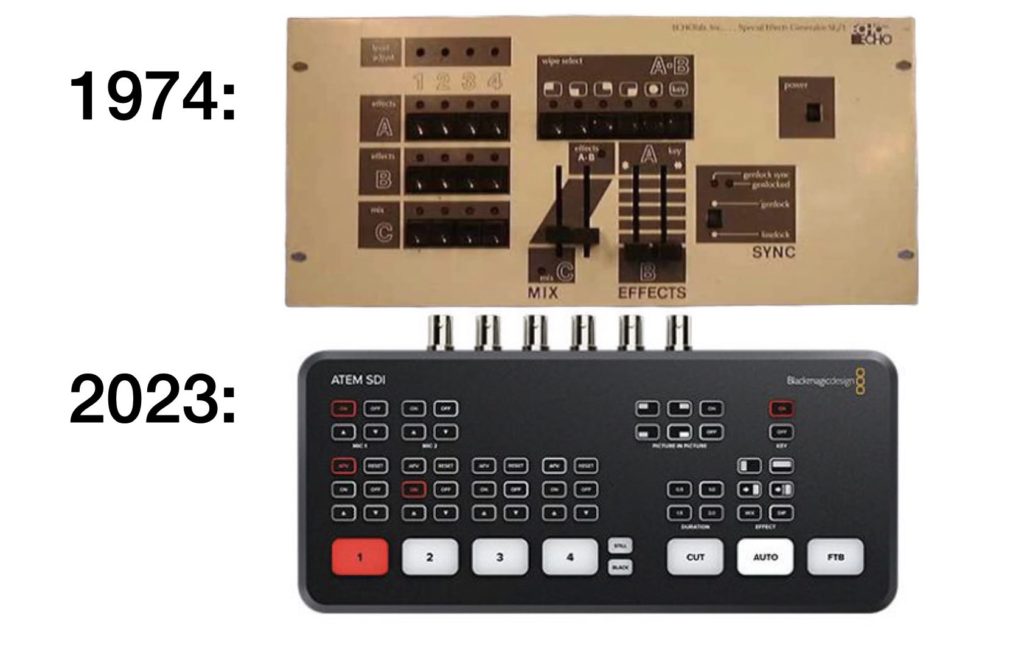Since I began dealing with broadcast television audio and video technology in high school in the 1980s, I greatly appreciate the fact that after purchasing classic industry leaders like ATEM (ECHOlab), DaVinci, Fairlight and Teranex, Blackmagic Design tends to keep the original names with products as they modernize them. The heritage and name behind the ATEM line of video mixers/switchers (previously known as SEGs or Special Effects Generators) goes back to ECHOlab from Billerica, Massachusetts in the northeast of the United States, when it was founded by the Whitaker family, whom I had the privilege of meeting personally. The first such device I used in high school in Connecticut was in fact the ECHOlab SE/1 Special Effects Generator. That was the greyscale/monochrome (“black & white”) version which was the predecessor to the ECHOlab SE/1c, the first color version. The high school hadn’t yet upgraded to a color studio. The original SE/1 used 6-pin DIN connections for cameras (separate horizontal and vertical sync, etc), but indeed used BNC for its outputs, the same locking bayonet connector used the modern SDI. In essence, the new U$345 ATEM SDI series returns to its original roots by using that BNC physical port, although the actual signal is quite different from the analog monochrome video of the SE/1 and the color component digital high definition one in any of today’s ATEM models.
About BNC
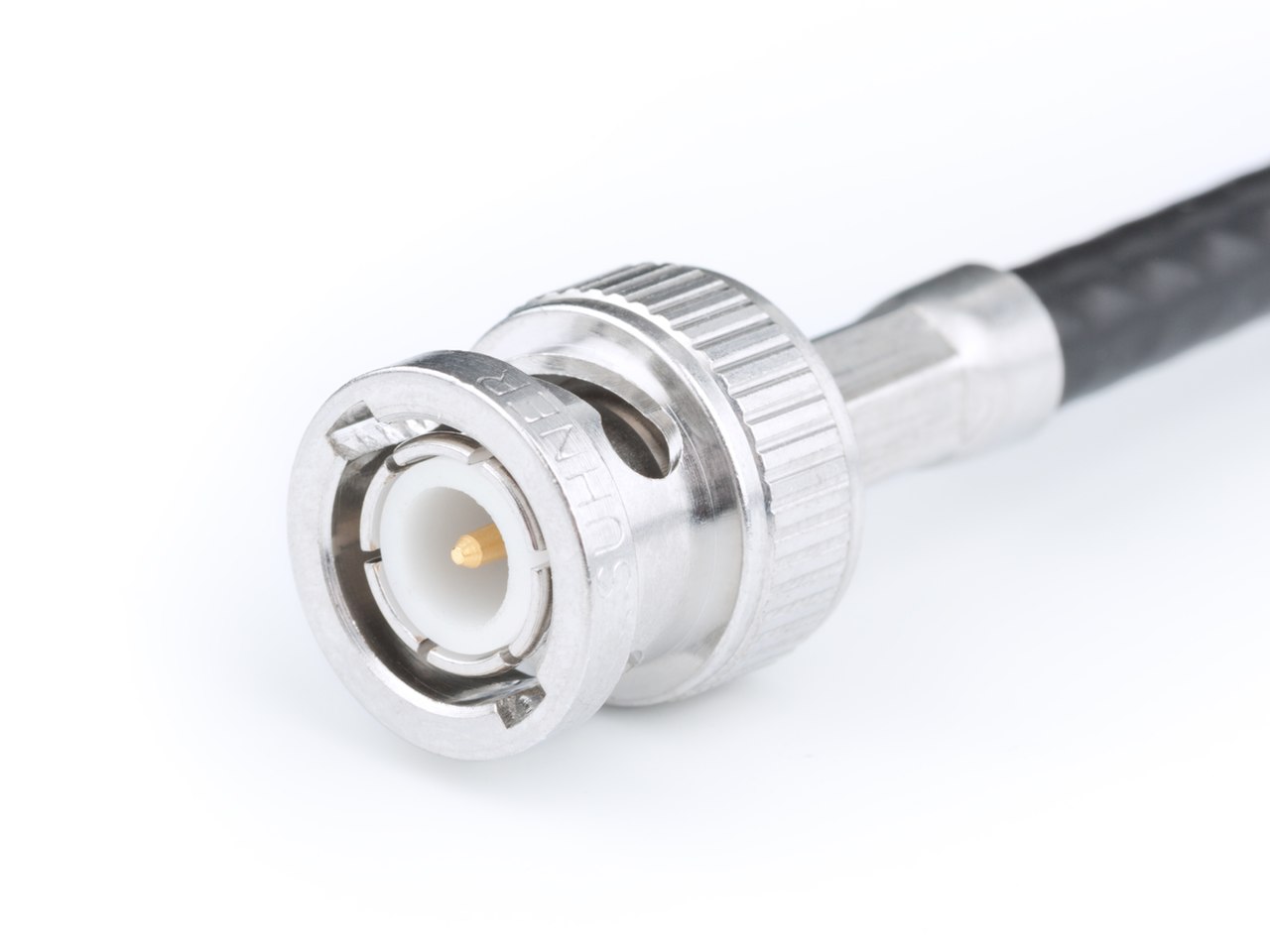
Despite what a funny fellow college student used to say in the eighties, BNC does not stand for “British Naval Connector”. According to my research, BNC stands for “Bayonet Neill–Concelman”. BNC is a locking miniature quick connect/disconnect connector used for coaxial cable.The BNC was introduced on military radio equipment in the 1940s and has since become widely applied in radio systems, and is a common type of video connector, both before & after color television and before & after digital television. The BNC with coaxial cable has also been used for local area networks, but has been mainly superseded by twisted pair cable with RJ-45 connectors in my observations. The letters N and C in BNC refer to the last names of its original designers, Paul Neill (1882 – 1968) and Carl Concelman (1912 – 1975).
I included the BNC factoid since it’s the connector used in SDI (covered ahead), which is the main interface on the ATEM SDI series from Blackmagic Design.
About HDMI
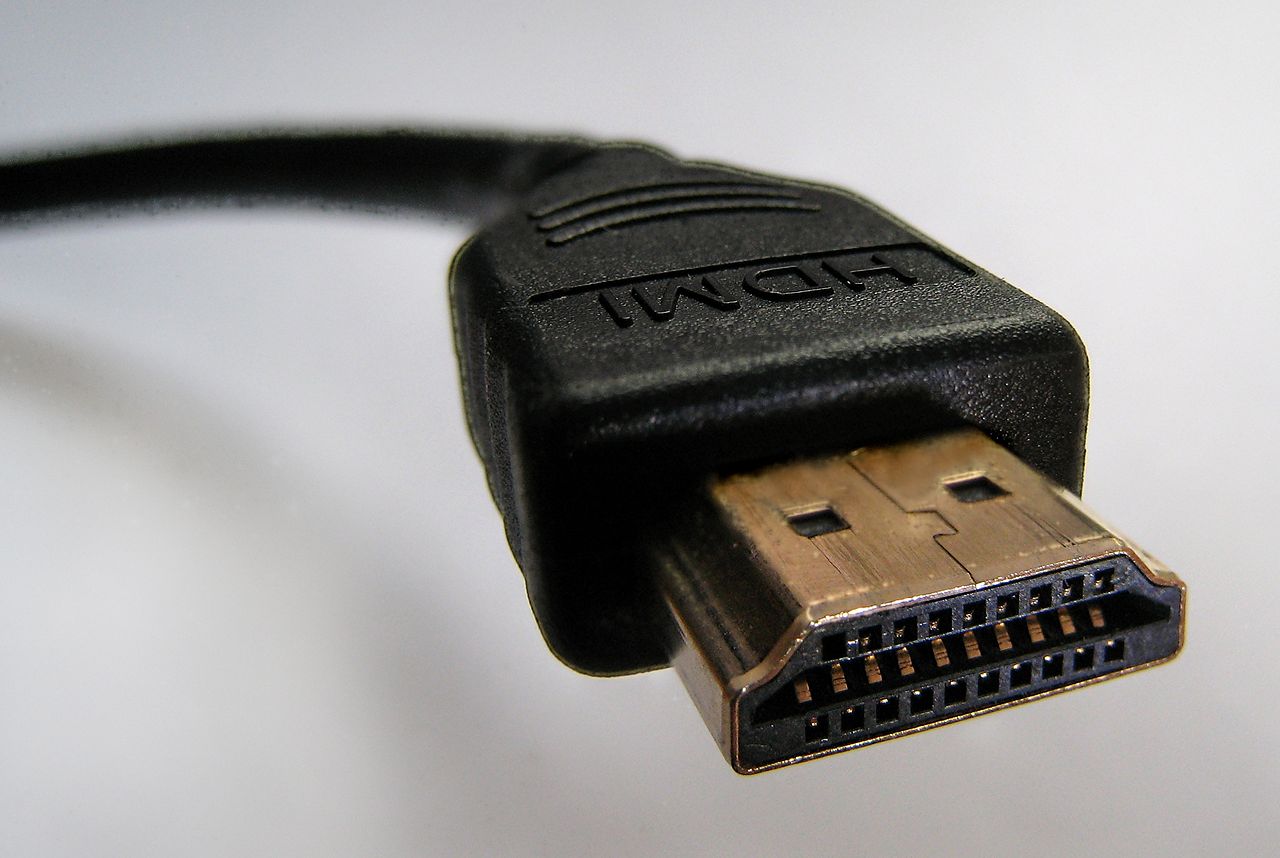
Born in the palindromic year of 2002, HDMI stands for High-Definition Multimedia Interface with at least three different sizes so far. Unlike the BNC covered in the prior section, which works for analog and digital signals, HDMI is a proprietary audio/video interface for transmitting uncompressed digital video data and compressed or uncompressed digital audio data from an HDMI-compliant source devices, such as a camera, display controller, to a compatible computer monitor, video projector, video monitor or television set, or digital video switcher.
I included the HDMI factoid since it’s the connector used in the existing ATEM Mini lineup from Blackmagic Design, where the ATEM SDI has come to accompany it with BNC for SDI, covered ahead.
About SDI
SDI stands for Serial Digital Interface. SDI is a family of digital video interfaces first standardized by SMPTE (Society of Motion Picture and Television Engineers) in 1989. SDI uses coaxial cable and the BNC covered earlier.
I included the SDI factoid since it’s the main interface used by the ATEM SDI lineup of devices from Blackmagic Design.
Advantages of SDI over HDMI
Maximum distance (without extra devices) and lockability are the main advantages of SDI over HDMI. Although locking HDMI connectors indeed exist on the market, they are scarce in the devices themselves. Few cameras have a locking HDMI port, and to my knowledge, the ATEM Mini devices don’t have locking HDMI connections either.
I have met producers who (before the release of the ATEM SDI devices) cringed at the idea of using ATEM with HDMI, for fear of unexpected disconnection during a live program if someone tripped on an HDMI cable. (I suppose the remaining fear may be a camera or ATEM SDI being pulled to the ground if someone trips on a coaxial SDI cable with BNC.) I suspect that the main reason that Blackmagic released the ATEM SDI series is because they heard of those producers who cringed about the two weaknesses in HDMI.
Interchangeability
HDMI cameras and other sources may indeed be connected to an ATEM SDI series using an HDMI-to-SDI converter, from Blackmagic Design or other sources. Before the existence of the ATEM SDI series, SDI cameras could be connected to ATEM Mini devices by using an SDI-to-HDMI converter from Blackmagic Design or other sources.
Comparing an ATEM SDI with its grandfather, the ECHOlab SE/1
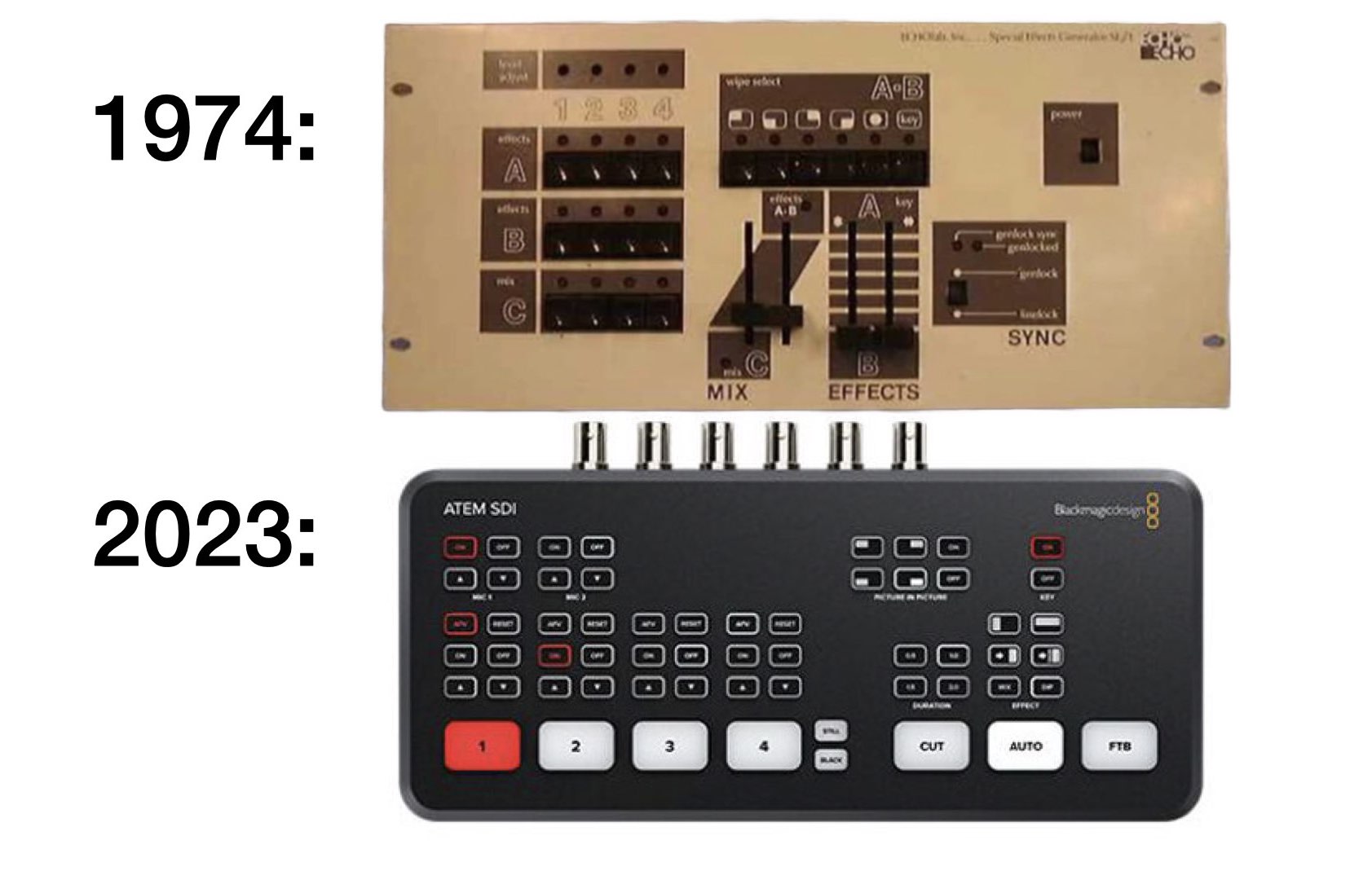
I imagine that in 1974 (or slightly before), ECHOlab engineers likely sat down in Billerica, Massachusetts, US to design what I suppose was likely its first entry level product, the ECHOlab SE/1. Their goals would be to make it work with the affordable video cameras of the day, using the current video signals. They designed the SE/1 to accept 4 sources.
In 2010, Blackmagic Design bought ECHOlab and presumably, its technology and patents. Blackmagic made several video switchers (aka video mixers or SEGs) using the ATEM name. The first (and still existing) ATEM Mini models use HDMI connections. Likely a couple of years ago, Blackmagic Design engineers sat down in Australia with similar goals for the entry level ATEM SDI: to accept 4 sources, to be compact and affordable. Of course, they knew that there was a market segment that prefers SDI (BNC) over HDMI. They also know that it should handle digital high-definition video and audio too. The ATEM Mini and ATEM SDI models also have digital video effects and Fairlight audio, neither of which was handled by its grandfather, the ECHOlab SE/1.
Where ATEM SDI (and ATEM Mini) thrive: ergonomics
In my opinion, both ATEM SDI and ATEM Mini thrive when the user wants physical buttons to execute cuts or other transitions while watching an external monitor of any desired size and at an appropriate height.
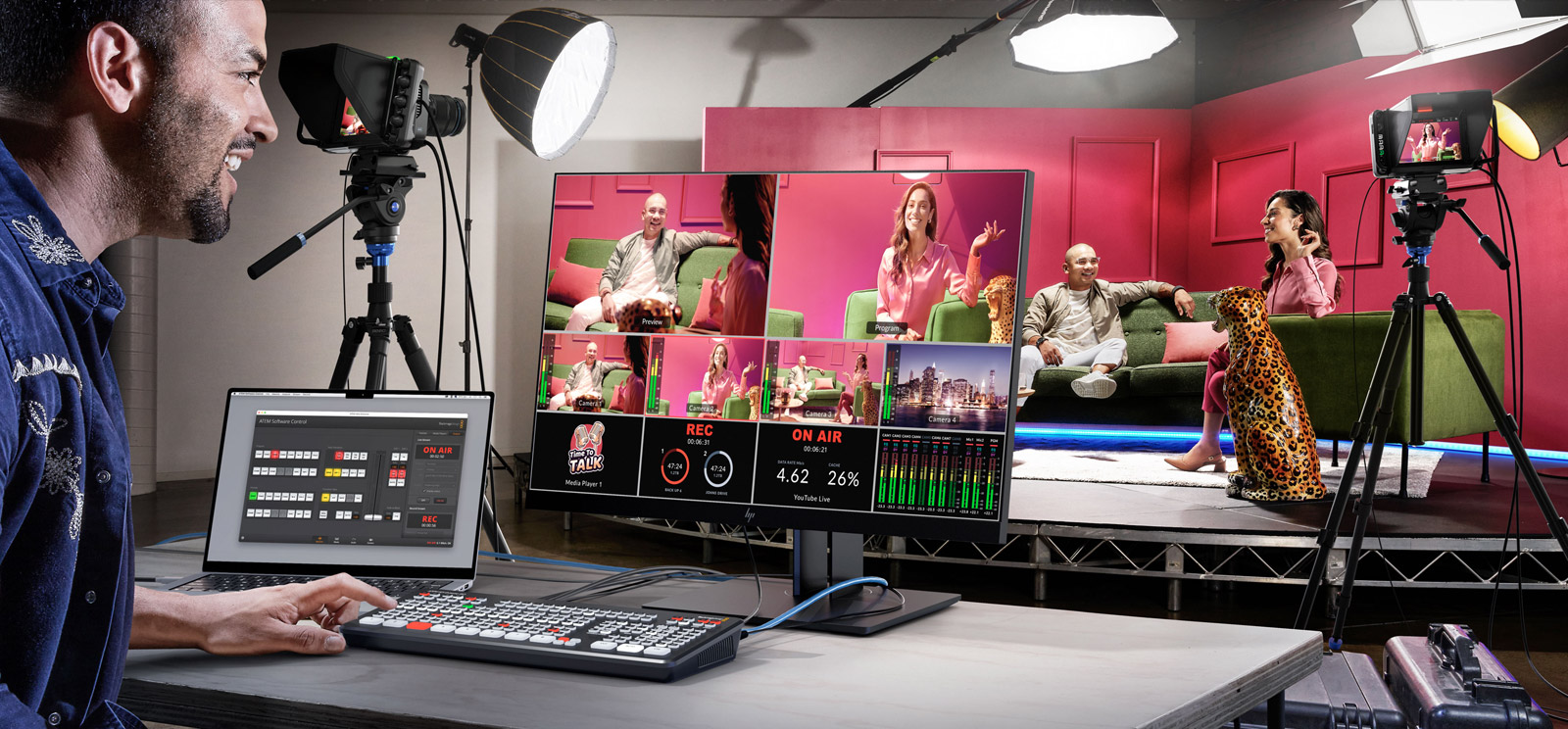
With physical buttons, the operator can memorize the position of each source or transition button and maintain eye contact with the monitor in front and usually higher up. Many users may find this traditional approach to be more ergonomic than with some of the competitors which use an all-in-one touchscreen, which forces the user to look downward. In fact, that’s why I like to do most of my typing for articles and books with a physical keyboard, sitting in an ergonomic chair while I look up onto a large matte (non-reflective) display at ergonomic height, not with a smartphone, tablet or laptop with a screen that would force me to be looking down.
ATEM SDI and ATEM Mini can also thrive when it is desired to have a separate operator in charge of updating electronic graphics being done in a separate, nearby computer.
Standalone switcher
Other than the requirement for power, an external monitor and video sources, the ATEM SDI may work standalone, meaning that ATEM SDI doesn’t require a nearby computer to be connected during operation. However, a nearby computer may be connected via USB-C or RJ-45 Ethernet to an ATEM SDI for software updates, to make adjustments (as I’ll cover ahead) or to send graphics to the ATEM SDI.
Interlaced and progressive in ATEM SDI models
ATEM SDI models can accept 720p (which by definition is only progressive), 1080i (be it true interlaced or PsF disguised as 1080i) or 1080p at any standard rate. On the output, the ATEM SDI models can only output progressive 1080p at any desired standard rate, which is fine for me, for many reasons. See more in the next section.
Fixing Type 3 camera shyness
The most important new fact I learned in conversations with Blackmagic Designs in preparation of this review is that although (as I covered in prior articles) it is indeed possible to create a custom XML file, fortunately it is not required for the most important reason I had been considering and discussing it before.
As I have covered in other articles, in full default operation, ATEM Mini and ATEM SDI set their output resolution and framerate according to the first source connected. That is very good when the source (i.e. camera) actually outputs the desired recording or live broadcast resolution and framerate. However, that is very bad when the first source connected is a “shy” camera which suffers from Type 3 shyness (as I covered in many articles, including my Review: Blackmagic Web Presenter HD streaming encoder + shyness fixer from 2021). For example, many 1080p cameras that suffer from Type 3 shyness, when set to shoot 1080/25p sadly double the live output framerate to 1080/50p… and when set to shoot at 1080/29.97p sadly output live 1080/59.94p. Both are a terrible waste of bandwidth and in some cases, can sadly make each frame suffer from extra compression artifacts downstream just because of a colossal misunderstanding. (This is the fault of the shy 1080p camera manufacturers, not the fault of the ATEM. but fortunately, the ATEM Mini or ATEM SDI can fix it in the case of Type 3 shyness).
Fortunately, after discussing it with Blackmagic, I discovered that is possible to set an ATEM Mini or ATEM SDI to output a specific resolution and framerate (i.e. 1080/25p or 1080/29.97p) without creating a custom XML file (as I was previously led to believe). Fortunately, setting a specific output setting like 1080/25p or 1080/29.97p can be done in the ATEM software in a connected computer via USB or RJ-45 Ethernet and then the ATEM Mini or ATEM SDI remembers that setting until told otherwise, even when no computer is connected. After doing that, even if you connect a shy 1080p camera outputting repeated frames (like 1080/25p sent as 1080/50p or 1080/29.97p sent as 1080/59.94p), the ATEM Mini or ATEM SDI will fortunately remove the repeated frames and output the desired 1080/25p or 1080/29.97p, thus avoiding the waste of bandwidth and extra compression artifacts suffered in the case where there is a limited bandwidth budget.
Audio with ATEM SDI
Audio can be sent to the ATEM SDI either embedded over SDI (i.e. from the camera’s microphone input) or via an unbalanced 3.5 mm stereo jack which offers bias voltage (aka “plugin power”) for unbalanced electret condenser microphones that require it.

The ATEM SDI has a total of two 3.5 mm unbalanced stereo inputs. The 3.5 mm inputs may be set via software to handle consumer line level inputs instead of mic level. See more information about this in my ATEM Mini and ATEM SDI wish list, ahead.
Controlled via software, ATEM SDI includes a Fairlight audio mixer with EQ and dynamics.
Other features in ATEM SDI
ATEM SDI includes DVE (digital video effects) for picture in picture, transition effects, green screen chromakey, 20 stills media pool for titles (with translucent or transparent alpha channel via PNG, TGA or GIF) and free ATEM Software Control, which requires a nearby computer.
My ATEM Mini and ATEM SDI wish list
In the future, I hope that Blackmagic Design will offer two new features:
- 4K UHD support (at least on the input) since that will not only solve Type 3 shyness (which can also be solved by the current ATEM Mini and ATEM SDI models), but also solve Type 1 and Type 2 shyness (which are currently solved in an imperfect way) since cameras are never shy when outputting 4K UHD.
- Balanced audio inputs (which Blackmagic Design already solved recently for its higher end ATEM switchers via its ATEM Microphone Converter. However, that converter only works with those devices with the MADI connection, which are not included with the ATEM Mini or ATEM SDI devices.
Conclusions
The U$345 ATEM SDI is a powerful yet affordable entry level device for those who mainly prefer SDI/BNC connections from camera sources. Its ATEM name pays homage to its ancestor, the ECHOlab SE/1. Although they share the same capabilities of switching from four physical sources, the ATEM SDI goes way beyond with high definition video, digital effects, chromakey and Fairlight audio. Of course, there are larger ATEM SDI models available too. For more information, BlackmagicDesign.com
Image credits
The ATEM SDI images are courtesy of Blackmagic Design.
The BNC image is courtesy of Swift.Hg via Creative Commons Attribution-ShareAlike 3.0 Unported (CC BY-SA 3.0).
The HDMI image is courtesy of I, D-Kuru vía Creative Commons Attribution-Share Alike 2.0 Austria license.
(Re-)Subscribe for upcoming articles, reviews, radio shows, books and seminars/webinars
Stand by for upcoming articles, reviews, books and courses by subscribing to my bulletins.
In English:
- Email bulletins, bulletins.AllanTepper.com
- In Telegram, t.me/TecnoTurBulletins
- Twitter (bilingual), AllanLTepper
En castellano:
- Boletines por correo electrónico, boletines.AllanTepper.com
- En Telegram, t.me/boletinesdeAllan
- Twitter (bilingüe), AllanLTepper
Most of my current books are at books.AllanTepper.com, and also visit AllanTepper.com and radio.AllanTepper.com.
FTC disclosure
Blackmagic Design is not paying for this review, although Blackmagic Design let the ATEM SDI to Allan Tépper to facilitate the review. He has since returned it. Some of the manufacturers listed above have contracted Tépper and/or TecnoTur LLC to carry out consulting and/or translations/localizations/transcreations. So far, none of the manufacturers listed above is/are sponsors of the TecnoTur, BeyondPodcasting, CapicúaFM or TuSaludSecreta programs, although they are welcome to do so, and some are, may be (or may have been) sponsors of ProVideo Coalition magazine. Some links to third parties listed in this article and/or on this web page may indirectly benefit TecnoTur LLC via affiliate programs. Allan Tépper’s opinions are his own. Allan Tépper is not liable for misuse or misunderstanding of information he shares.
The BNC image is courtesy of Swift.Hg via Creative Commons Attribution-ShareAlike 3.0 Unported (CC BY-SA 3.0).
The HDMI image is courtesy of I, D-Kuru vía Creative Commons Attribution-Share Alike 2.0 Austria license.

Filmtools
Filmmakers go-to destination for pre-production, production & post production equipment!
Shop Now